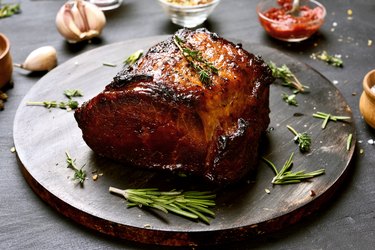
Open your oven door. If you see a fan at the back or on the side of the cavity, you actually have two appliances in one: a conventional and a convection oven. The conventional oven uses the coils at the bottom to radiate heat upward. In a convection oven, circulation fans distribute the heat evenly throughout the cavity, giving the food inside a consistent source of heat for cooking.
Long the preferred oven of professional cooks, the convection oven cooks evenly in a shorter period of time. It is also more energy efficient and doesn't create hot spots within the oven. Though it's not ideal for cakes or biscuits because of the heat swirling over the top and drying it out before it's cooked thoroughly, the convection oven does perform superbly when used to convection roast pork chops or a pork roast. The tops are browned, the interior is moist and it's all done in less time than in a conventional oven.
Video of the Day
Video of the Day
Convection Roasted Pork Chops
Most meat comes out of a convection oven crispy and moist. The key to an even bake is to use a roasting pan with low sides. The air circulating throughout the oven needs to get to the sides of the roast or chops, and high sides prevent thorough circulation. With warm air circulating all around the tray of chops, they emerge from the oven well browned and juicy.
The key to convection roasting pork or any meat is to bring it to room temperature before seasoning. A wet seasoning or marinade helps keep the moisture inside and gives the outside a nice brown glow. Adding chicken broth to the bottom of the roasting pan moisturizes the meat.
Adjusting for Convection Ovens
Most recipes are written for conventional ovens, and some even include fan settings for a convection oven. A simple rule of thumb is to reduce the temperature of the conventional oven setting by 25 degrees or reduce the cooking time by 25 percent. A meat thermometer inserted prior to convection roasting the pork relieves you of having to open the oven and lose heat just to test for doneness.
Pork, the Other White Meat
Most people prefer their pork well done. That means it tastes more like shoe leather than juicy pork, necessitating sauces and compotes to add flavor. No longer are pork-borne illnesses a source of fear, allowing it to be served with pink insides.
Set the convection oven temperature to 425 degrees Fahrenheit and let it heat up for just a few minutes, unlike the conventional oven that takes upward of 20 minutes to come up to temperature. Insert a meat thermometer into the roast. The higher fan speeds allow the exterior to brown and crisp.
Pour some chicken broth into the bottom of the roasting pan, place the loin into it and set it in the oven. Convection roast the pork for 25 minutes or until the meat thermometer reads 145 to 150 degrees Fahrenheit. Remove the roast from the oven and let it sit for a few minutes. This allows the juices to settle into the roast instead of being spilled out onto your chopping board when you slice it.
Convection Oven Pork Chops
Just as the large, round pork loin cooks quicker in a convection oven, so does a smaller pork chop. If the chop is thin, you'll have a juicier chop if you sear it on the stove top and then place the skillet into a 400-degree convection oven for 10 minutes. Chicken broth added to the bottom of the pan is a savior and serves as the base for tasty pork gravy.